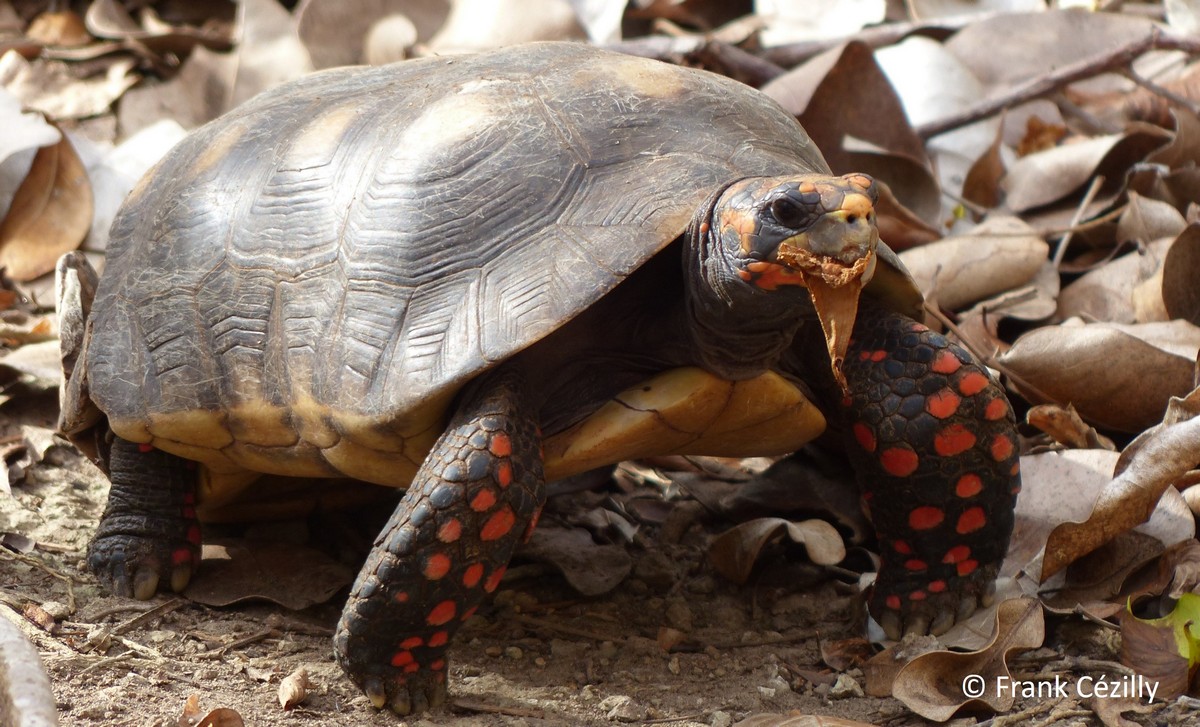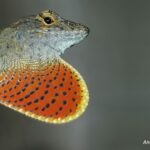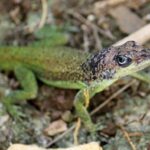
- Common name : Red-footed tortoise.
- Scientific name : Chelonoidis carbonarius (Spix, 1824)
- Local name : Red-leg, Red-legged, Savanna tortoise, Tortue charbonnière à pattes rouges, Köhlerschildkröte, Jaboti, Jabuti, Jabuti-Piranga, Jabuti-Vermelho, Japuta, Carumbe / Karumbe, Wayapopi, Morrocoy, Kati, Sambo.
- Order : Testudines
- Family : Testudinidae
Morphology. Medium sized freshwater turtle. The carapace is black, marked with light spots in the middle of each scute. The head and limbs are black, spotted with bright colours from yellow to dark red. Characteristic of the genus Chelonoidis, the nuchal scute is absent and the carapace possess a large, undivided supracaudal scute (Ernst and Leuteritz, 1999).
Standard body size (carapace length). 400 to 600 mm (Ernst et Leuteritz, 1999).
Sexual dimorphism. Males are usually larger than females (Ernst et Leuteritz, 1999).
Variations. The colour of the carapace, head and limbs varies according to a North-South gradient over its native range. Five variants are thus identified.
Possible confusion with other species. Confusion is possible with the Yellow-footed tortoise, C. denticulatus, a phylogenetically close species, native to the Amazon basin and also present in Guadeloupe (introduced but not established; INPN, 2021), in Dominica (introduced; IUCN redlist, 2021) and in Trinidad (uncertain status) (Vargas-Ramirez et al., 2010; Wang et al., 2011).
Distribution
Native. Panama, Colombia, Venezuela (Rivas et al., 2012), Guyana (Cole et al., 2013), Surinam, French Guiana, Ecuador, Peru, Bolivia (Montaño et al., 2013; Noss et al., 2013), Brazil (Wang et al., 2011; Santos et al., 2014; de Freitas et al., 2018, 2019; Ferreira, 2021; Shibuya et al., 2021), Paraguay (Vinke et Vinke, 2001; Cacciali et al., 2016), Argentina.
Introduced. Caribbean: Puerto Rico, US and British Virgin Islands, Antigua, Barbuda (Daltry, 2007), Guadeloupe, Dominica, Martinique, Sainte Lucia, Saint Vincent and the Grenadines (Daudin and Silva, 2007), Grenada, Barbados, Trinidad, Tobago.
Uncertain status. Great Corn Island (Nicaragua) (Salazar-Saavedra et al., 2015).
Biology and ecology
Habitat. Chelonoidis carbonarius inhabit various habitats, from savannah to wet forests (Vinke et Vinke, 2001; Vargas-Ramirez et al., 2010).
Diet. Omnivore. The species can feed on plants (weeds, fruits and seeds), mushroom, mollusks, curstacean, insects and carrion (Wang et al., 2011; Mourthe and Castro, 2017; Shibuya et al., 2021).
Reproduction. C. carbonarius is generally reach maturity at five. The egg-laying period takes place during the wet season (between June and September). Females lay eggs several times during this period, laying two to fifteen eggs per nest.
Behaviour. On its native range, the dry season can lead to the temporary disappearance of water ponds. C. carbonarius can then aestivate, buried in mud or sand, while awaiting the return of more favourable conditions.
Impact and management of introduced populations
Impact. Little is known about the impact of Chelonoidis carbonarius on native ecosystems in introduced regions.
Management. No targeted control measures have been established in the regions where the species has been introduced.
Bibliographie
- Cacciali, P., Scott, N. J., Luz, A., Ortíz, A., Fitzgerald, L. A., & Smith, P. (2016). The Reptiles of Paraguay: literature, Distribution, and an annotated taxonomic checklist. Special Publication of The Museum of Southwestern Biology, 11, 1–373.
- Cole, C. J., Townsend, C. R., Reynolds, R. P., MacCulloch, R. D., & Lathrop, A. (2013). Amphibians and reptiles of Guyana, South America: Illustrated keys, annotated species accounts, and a biogeographic synopsis. Proceedings of the Biological Society of Washington, 125, 317–578.
- Daltry, J. C. (2007). An introduction to the herpetofauna of Antigua, Barbuda and Redonda, with some conservation recommendations. Applied Herpetology, 4, 97–130.
- Daudin, J., & De Silva, M. (2007). An annotated checklist of the amphibians and terrestrial reptiles of the Grenadines with notes on their local natural history and conservation. Applied Herpetology, 4, 163–175.
- de Freitas, M. A., Abegg, A. D., Araújo, D. da S., Coelho, H. E. de A., Azevedo, W. dos S., Chaves, M. F., … de Moura, G. J. B. (2019). Herpetofauna of three “Brejos de altitude” in the interior of the state of Pernambuco, northeastern Brazil. Herpetology Notes, 12, 591–602.
- de Freitas, M. A., Abegg, A. D., Dias, I. R., & Moraes, E. P. D. F. (2018). Herpetofauna from Serra da Jibóia, an Atlantic Rainforest remnant in the state of Bahia, northeastern Brazil. Herpetology Notes, 11, 59–72.
- Ernst, C. H., & Leuteritz, T. E. J. (1999). Geochelone carbonaria (Spix) Red-footed tortoise. In Catalogue of American Amphibians and Reptiles.
- Ferreira, A. S. (2021). Rapid survey of the herpetofauna of Estação Ecológica Alto Maués: a rarely accessed area in the Brazilian Amazonia. Biota Amazônia, 11, 22–28.
- Montaño F., R., Cuéllar, E., Fitzgerald, L., Soria, F., Mendoza, F., Peña, R., … Noss, A. (2013). Ranging patterns by the Red-footed tortoise – Geochelone carbonaria (Testudines: Testudinidae) – in the Bolivian Chaco. Ecología En Bolivia, 48, 17–30.
- Mourthe, I., & Castro, A. (2017). Chelonoidis carbonaria (Red-footed Tortoise). Scavenging behavior. Herpetological Review, 48, 422–423.
- Noss, A. J., Montaño F, R. R., Soria, F., Deem, S. L., Fiorello, C. V., & Fitzgerald, L. A. (2013). Chelonoidis carbonaria (Testudines: Testudinidae) Activity patterns and burrow use in the Bolivian Chaco. South American Journal of Herpetology, 8, 19–28.
- Rivas, G. A., Molina, C. R., Ugueto, G. N., Barros, T. R., Barrio-Amorós, C. L., & Kok, P. J. R. (2012). Reptiles of Venezuela: An updated and commented checklist. Zootaxa, 64, 1–64.
- Salazar-Saavedra, M., Loza, J. C., Fernandez, M., Martinez-Fonseca, J. G., Dwyer, Q., & Sunyer, J. (2015). Chelonoidis carbonarius (Spix, 1824): a member of the Nicaraguan herpetofauna. Mesoamerican Herpetology, 2, 571–573.
- Santos, D. L., de Andrade, S. P., Victor, E. P., & Vaz-Silva, W. (2014). Amphibians and reptiles from southeastern Goiás, Central Brazil. Check List, 10, 131–148.
- Shibuya, P. S., Tortato, M. A., Gustavo, L., & Oliveira, R. (2021). Home-range size and activity of the Red-footed Tortoise, Chelonoidis carbonarius (Spix , 1824) in a Brazilian coastal shrub area. Herpetology Notes, 14, 785–789.
- Vargas-Ramírez, M., Maran, J., & Fritz, U. (2010). Red- And yellow-footed tortoises, Chelonoidis carbonaria and C. denticulam (Reptilia: Testadines: Testudinidae), in South American savannahs and forests: Do their phylogeographies reflect distinct habitats? Organisms Diversity and Evolution, 10(2), 161–172.
- Vinke, T., & Vinke, S. (2001). The turtle and tortoise fauna of the central Chaco of Paraguay. Radiata, 10, 1–19.
- Wang, E., Donatti, C. I., Ferreira, V. L., Raizer, J., & Himmelstein, J. (2011). Food Habits and Notes on the Biology of Chelonoidis carbonaria (Spix 1824) (Testudinidae, Chelonia) in the Southern Pantanal, Brazil. South American Journal of Herpetology, 6, 11–19.





